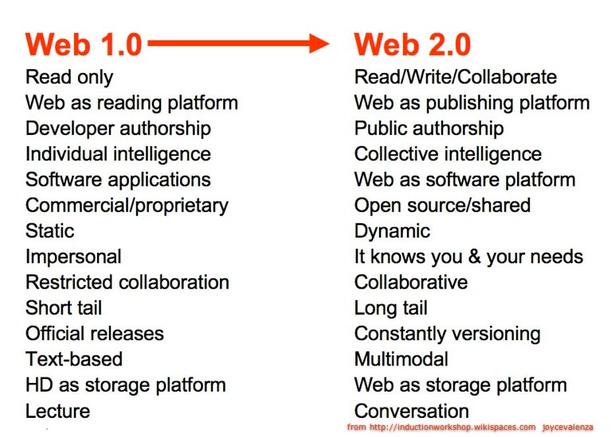Web 2.0
From DigitalRhetoricCollaborative
Contents |
[edit] Introduction
Web 2.0 is a term used to describe sites that emphasize user-generated content, usability, and interoperability.
The term was popularized by Tim O'Reilly and Dale Dougherty at the O'Reilly Media Web 2.0 Conference in late 2004, though it was first coined by Darcy DiNucci in 1999.
[edit] Web 1.0 vs. web 2.0
[edit] Characteristics of a web 1.0 site
Some design elements of a Web 1.0 site include:
- Static pages instead of dynamic HTML.
- Content served from the server's filesystem instead of a RDBMS.
- Pages built using Server Side Includes or Common Gateway Interface or CGI instead of a web application written in a dynamic programming language such as PHP or Ruby.
- The use of HTML 3.2-era elements such as Framing (World Wide Web) or frames and tables to position and align elements on a page. These were often used in combination with spacer GIFs.
- Proprietary HTML extensions, such as the <blink> element and <marquee> tags, introduced during the "Browser wars".
- Online guestbooks.
- GIF buttons, graphics (typically 88x31 pixels in size) promoting web browsers, operating systems, text editors and various other products.
- HTML forms sent via email. Support for server side scripting was rare on shared servers during this period. To provide a feedback mechanism for web site visitors, mailto were used. A user would fill in a form, and upon clicking the form's submit button, their email client would launch and attempt to send an email containing the form's details. The popularity and complications of the mailto protocol led browser developers to incorporate email clients into their browsers.
[edit] Characteristics of a web 2.0 site
Instead of merely reading a Web 2.0 site, a user is invited to contribute to the site's content by commenting on published articles or creating a user account or user profile on the site, which may enable increased participation. By increasing emphasis on these already-extant capabilities, they encourage the user to rely more on their browser for user interface]], application software and file storage facilities. This has been called "network as platform" computing.
These sites may have an "architecture of participation" that encourages users to add value to the application as they use it. Some scholars have put forth cloud computing as an example of Web 2.0 because cloud computing is simply an implication of computing on the Internet.
Web 2.0 offers all users the same freedom to contribute.
While this opens the possibility for serious debate and collaboration, it also increases the incidence of Spam (electronic) and trolling" by unscrupulous or misanthropic users. The impossibility of excluding group members who don’t contribute to the provision of goods from sharing profits gives rise to the possibility that serious members will prefer to withhold their contribution of effort and Free rider problem on the contribution of others. This requires what is sometimes called radical trust by the management of the Web site.
[edit] The key features of Web 2.0
- Folksonomy - free classification of information; allows users to collectively classify and find information (e.g. Tag (metadata)|tagging)
- Rich User Experience - dynamic content; responsive to user input
- User Participation - information flows two ways between site owner and site user by means of evaluation, review, and commenting. Site users add content for others to see
- Software as a service - Web 2.0 sites developed APIs to allow automated usage, such as by a Web app or mashup (web application hybrid)
[edit] Popular Web 2.0 sites
Some of the most popular web 2.0 sites are:
- YouTube
- Wikipedia
- WordPress
- Tumblr
- Weebly
- IMDB
- Yelp
- eHow
- Flickr
They grow in size and gain popularity when interesting content is added to that site. People find it, share it and discuss it. Facebook has not spent a single dollar on advertising, yet more than 1 billion are active on that platform every day according to this press release in August 2015.

